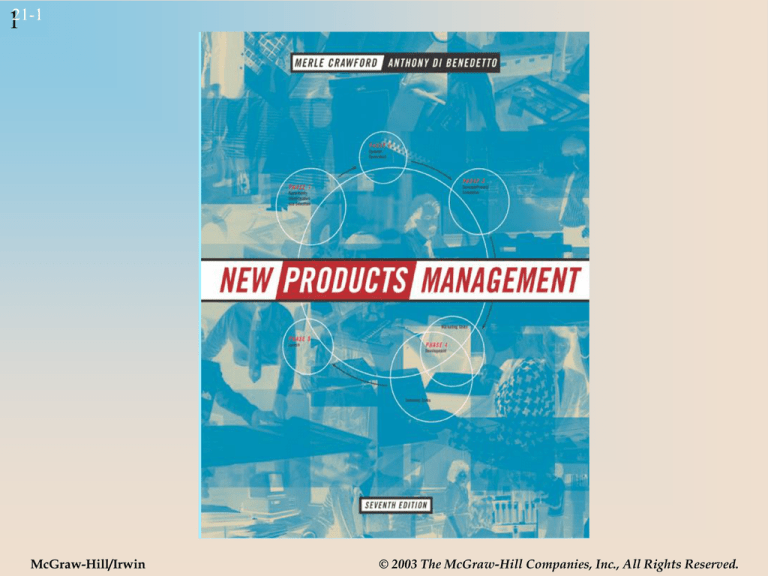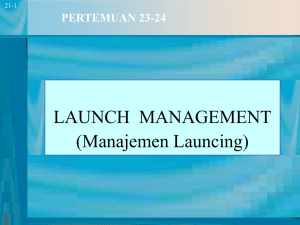
121-1
McGraw-Hill/Irwin
© 2003 The McGraw-Hill Companies, Inc., All Rights Reserved.
221-2
CHAPTER TWENTY-ONE
LAUNCH MANAGEMENT
321-3
Launch Management Concept Showing
Remedial Action
Figure 21.1
% aware who
have tried
As of now
Goal
With action
Without action
Plan
Actual
Launch
Now
6 months
Time
421-4
The Launch Management System
• Spot potential problems.
• Select those to control.
– Consider expected impact/damage.
• Develop contingency plans for the management of
problems.
• Design the tracking system.
– Select variables.
– Devise measuring system.
– Select trigger points.
Adage: in driving a car, it is the potholes you don’t know
about (or forget about) that cause you damage.
521-5
Spotting Potential Problems
•
•
•
•
Problems section from the situation analysis.
Role-play what competitors will do.
Look back over all the data in the new product's "file."
Consider hierarchy of effects needed to result in a
satisfied customer (A-T-A-R).
621-6
A-T-A-R Hierarchy: Where Does the
Problem Lie?
Figure 21.2
Tried
Reused
Not R.
Aware
Not
Tried
Unaware
Does the problem lie in awareness,
trial, or repeat?
721-7
Decision Model for Building Launch
Control Plan
Figure 21.3
821-8
Problems at Launch: Philips DCC Machine
• Advertising: Missed lack of product understanding; used
DCC term without defining it.
• Resellers: In relaunch, marketed only to those dealers who
supported and were willing to invest in the concept.
• Price: Cut price too much, depleted inventories, dealers
sent back tapes.
• Consumer Attitudes: Preferred CD-ROMs to DCC tape
format (whether right or not).
All of these problems could have been identified and managed!
921-9
Select the Control Events
Of all potential problems,
• Which have enough impact to warrant investigation?
• Which of these ought to be given special consideration?*
• Which of these should be given contingency planning?
• And which of these need to be tracked?
*Basis: Consider potential damage and likelihood
of occurrence.
21-10
10
Develop Contingency Plans
• "Is there anything we can do?"
– E.g.: competitive price cut or product imitation.
• Base contingency plan on type of problem:
– 1. A company failure (e.g., inadequate
distribution)
– 2. A consumer failure (e.g., low awareness or
trial)
21-11
11
Designing the Tracking System
• Select the tracking variables
–
Relevant, measurable, predictable
• Select the trigger points
• Consider the nontrackable problems
21-12
12
Questions from New Product Tracking
Study
Figure 21.6
Category Usage Questions
In the past six months, how many times have you bought (product
category)?
What brands of (product category) have you ever heard of?
Have you ever heard of (brand)? (Ask for 4 to 6 brands)
Have you ever bought (brand)? (Ask for 4 to 6 brands)
About how many times have you bought (brand) in the past six months?
Advertising Awareness Questions
Do you recall seeing any advertising for (brand)? (ask all brands
respondent is aware of)
Describe the advertising for (brand).
Where did you see the advertising for (brand)?
21-13
13
Questions from New Product Tracking
Study (continued)
Figure 21.6
(cont’d.)
Purchase Questions
Have you ever bought (brand)?
If "Yes":
If "No":
How many times have you bought it?
How likely are you to buy (brand) again?
What did you like/dislike about (brand)?
What do you think of the price of
(brand)?
Did you look for (brand) in the
store?
Why didn't you try (brand)?
How likely are you to try (brand)
in the future?
21-14
14
A Sample Launch Management Plan
Figure 21.7
Potential Problem
Salespeople fail to contact general-purpose market at prescribed
rate.
Tracking
Track weekly sales call reports (plan is for at least 10 generalpurpose calls per week per rep).
Contingency Plan
If activity falls below this level for three weeks running, a
remedial program of one-day district sales meetings will be
held.
21-15
15
Another Problem Illustrated
Figure 21.7
(cont’d.)
Potential Problem
Potential customers are not making trial purchases of the
product.
Tracking
Begin a series of 10 follow-up calls a week to prospects.
There must be 25% agreement on product's main feature
and trial orders from 30% of those prospects that agree
on the feature.
Contingency Plan
Special follow-up phone sales calls to all prospects by
reps, offering a 50% discount on all first-time purchases.
21-16
16
A Stepwise Product Deletion Process
Figure 21.8
Recognition of the product to
be deleted
Analysis and revitalization stage
Evaluation and decision formulation stage
Implementation stage
Source: George J. Avlonitis, Susan J. Hart, and Nikolaos X. Tzokas, “An Analysis of Product Deletion
Scenarios,” Journal of Product Innovation Management, Vol. 17, No. 1, January 2000, pp. 41-56.




